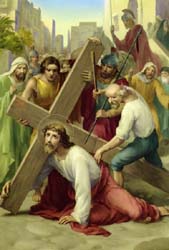neither clothes nor shoes. Her sustenance consisted of a few grams of food, which were prepared for her by her assistant, Rosaria Bucci.
Her life a continuous miracle
Luisa ordered nothing, desired nothing, and instantly vomited the food she swallowed. She did not look like a person near death’s door, but nor did she appear perfectly healthy. Yet she was never idle, she spent her energy either in her daily suffering or her work; and her life, for those who knew her well, was considered a continuous miracle.
She returned money people sent
Her detachment from any payments that did not come from her daily work was marvelous! She firmly refused money and the various presents offered to her under any pretext whatsoever. She never accepted money for the publication of her books. Thus one day she told Blessed Annibale that she wanted to give him the money from her author’s royalties: “I have no right to it, because what is written there is not mine” (cf. Preface of the L’orologio della Passione, Messina, 1926). She scornfully refused and returned the money that pious people sometimes sent her.
Luisa’s house was like a monastery, not to be entered by any curious person. She was always surrounded by a few women who lived according to her own spirituality, and by several girls who came to her house to learn lace-making. Many religious vocations emerged from this “upper room.” However,
her work of formation was not limited to girls alone, many young men were also sent by her to various religious institutes and to the priesthood.

Jesus in a vision to Luisa Piccarreta
cries to her “Soul, help Me!”
Her day began at about 5.00 a.m., when the priest came to the house to bless it and to celebrate Holy Mass. Either her confessor officiated, or some delegate of his: a privilege granted by Leo XIII and confirmed by St. Pius X in 1907.
After Holy Mass, Luisa would remain in prayer and thanksgiving for about two hours. At about 8.00 a.m., she would begin her work which she continued until midday; after her frugal lunch she would stay alone in her room in meditation. In the afternoon – after several hours of work – she would recite the holy Rosary. In the evening, towards 8.00 p.m., Luisa would begin to write her diary; at about midnight she would
fall asleep. In the morning she would be found immobile, rigid, huddled up on her bed, her head turned to the right, and the intervention of priestly authority would be necessary to recall her to her daily tasks and allow her to sit up in bed.
Body never suffered rigor mortis
Luisa died at the age of eighty-one years, ten months and nine days, on March 4, 1947, after a fortnight of illness, the only one diagnosed in her life, a bad attack of pneumonia. She died at the end of the night, at the same hour when every day the priest’s blessing had freed her from her state of rigidity. Archbishop Francesco Petronelli (May 25, 1939-June 16, 1947) was the archbishop at the time. Luisa remained sitting up in bed. It was impossible to lay her out, and her body never suffered rigor mortis and remained in the position in which it had always been.
“Luisa the Saint has died”
Hardly had the news of Luisa’s death spread, like a river in full spate, all the people streamed into her house, and police intervention was necessary to control the crowds that flocked there day and night to visit Luisa, a woman very dear to them. A voice rang out: “Luisa the Saint has died. ”
To contain all the people who were going to see her, with the permission of the civil authorities and health officials, her body was exposed for four days with no sign of corruption.

